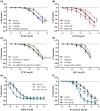Pentoxifylline as a therapeutic option for pre-eclampsia: a study on its placental effects
- PMID: 35861684
- PMCID: PMC9804511
- DOI: 10.1111/bph.15931
Pentoxifylline as a therapeutic option for pre-eclampsia: a study on its placental effects
Abstract
Background and purpose: Recently pentoxifylline, a non-selective phosphodiesterase inhibitor and adenosine receptor antagonist, has attracted much interest for the treatment of the increased vascular resistance and endothelial dysfunction in pre-eclampsia. We therefore investigated the placental transfer, vascular effects and anti-inflammatory actions of pentoxifylline in healthy and pre-eclamptic human placentas.
Experimental approach: The placental transfer and metabolism of pentoxifylline were studied using ex vivo placenta perfusion experiments. In wire myography experiments with chorionic plate arteries, pentoxifyllines vasodilator properties were investigated, focusing on the cGMP and cAMP pathways and adenosine receptors. Its effects on inflammatory factors were also studied in placental explants.
Key results: Pentoxifylline transferred from the maternal to foetal circulation, reaching identical concentrations. The placenta metabolized pentoxifylline into its active metabolite lisofylline (M1), which was released into both circulations. In healthy placentas, pentoxifylline potentiated cAMP- and cGMP-induced vasodilation, as well as causing vasodilation by adenosine A1 antagonism and via NO synthase and PKG. Pentoxifylline also reduced inflammatory factors secretion. In pre-eclamptic placentas, we observed that its vasodilator capacity was preserved, however not via NO-PKG but likely through adenosine signalling. Pentoxifylline neither potentiated vasodilation through cAMP and cGMP, nor suppressed the release of inflammatory factors from these placentas.
Conclusion and implications: Pentoxifylline is transferred across and metabolized by the placenta. Its beneficial effects on the NO pathway and inflammation are not retained in pre-eclampsia, limiting its application in this disease, although it could be useful for other placenta-related disorders. Future studies might focus on selective A1 receptor antagonists as a new treatment for pre-eclampsia.
Keywords: inflammation; nitric oxide; pentoxifylline; phosphodiesterase; placenta; pre-eclampsia; vasodilation.
© 2022 The Authors. British Journal of Pharmacology published by John Wiley & Sons Ltd on behalf of British Pharmacological Society.
Conflict of interest statement
We have no conflicts of interest to disclose.
Figures






Similar articles
-
Placental effects and transfer of sildenafil in healthy and preeclamptic conditions.EBioMedicine. 2019 Jul;45:447-455. doi: 10.1016/j.ebiom.2019.06.007. Epub 2019 Jun 14. EBioMedicine. 2019. PMID: 31204276 Free PMC article.
-
l-Tryptophan-Induced Vasodilation Is Enhanced in Preeclampsia: Studies on Its Uptake and Metabolism in the Human Placenta.Hypertension. 2020 Jul;76(1):184-194. doi: 10.1161/HYPERTENSIONAHA.120.14970. Epub 2020 Jun 1. Hypertension. 2020. PMID: 32475317
-
Systemic and fetal-maternal nitric oxide synthesis in normal pregnancy and pre-eclampsia.Br J Obstet Gynaecol. 1996 Sep;103(9):879-86. doi: 10.1111/j.1471-0528.1996.tb09906.x. Br J Obstet Gynaecol. 1996. PMID: 8813307
-
Hormonal regulation of placental nitric oxide and pathogenesis of pre-eclampsia.Trends Mol Med. 2006 May;12(5):223-33. doi: 10.1016/j.molmed.2006.03.003. Epub 2006 Apr 17. Trends Mol Med. 2006. PMID: 16616640 Review.
-
Potential cell signalling mechanisms involved in differential placental angiogenesis in mild and severe pre-eclampsia.Curr Vasc Pharmacol. 2009 Oct;7(4):475-85. doi: 10.2174/157016109789043865. Curr Vasc Pharmacol. 2009. PMID: 19485894 Review.
Cited by
-
Pentoxifylline in COVID-19 and considerations for its research in long COVID.Inflamm Res. 2024 Dec;73(12):2057-2068. doi: 10.1007/s00011-024-01942-0. Epub 2024 Oct 24. Inflamm Res. 2024. PMID: 39446164 Free PMC article.
-
Pentoxifylline uses in inner ear diseases.Eur J Clin Pharmacol. 2025 Jul;81(7):955-999. doi: 10.1007/s00228-025-03844-4. Epub 2025 May 7. Eur J Clin Pharmacol. 2025. PMID: 40332573 Review.
-
From Hypoxia to Oxidative Stress: Antioxidants' Role to Reduce Male Reproductive Damage.Reprod Sci. 2025 Feb;32(2):261-277. doi: 10.1007/s43032-024-01746-x. Epub 2024 Nov 18. Reprod Sci. 2025. PMID: 39557807 Review.
-
Statins Prevent the Deleterious Consequences of Placental Chemerin Upregulation in Preeclampsia.Hypertension. 2024 Apr;81(4):861-875. doi: 10.1161/HYPERTENSIONAHA.123.22457. Epub 2024 Feb 15. Hypertension. 2024. PMID: 38361240 Free PMC article.
-
Pharmacokinetics of betamethasone in pre-eclampsia: An in vivo and ex vivo study.Br J Clin Pharmacol. 2025 Aug;91(8):2327-2339. doi: 10.1002/bcp.70035. Epub 2025 Mar 13. Br J Clin Pharmacol. 2025. PMID: 40083164 Free PMC article.
References
-
- Alexander, S. P. , Christopoulos, A. , Davenport, A. P. , Kelly, E. , Mathie, A. , Peters, J. A. , Veale, E. L. , Armstrong, J. F. , Faccenda, E. , Harding, S. D. , Pawson, A. J. , Southan, C. , Davies, J. A. , Abbracchio, M. P. , Alexander, W. , Al‐hosaini, K. , Bäck, M. , Barnes, N. M. , Bathgate, R. , … Ye, R. D. (2021). THE CONCISE GUIDE TO PHARMACOLOGY 2021/22: G protein‐coupled receptors. British Journal of Pharmacology, 178(S1), S27–S156. 10.1111/bph.15538 - DOI - PubMed
-
- Alexander, S. P. , Fabbro, D. , Kelly, E. , Mathie, A. , Peters, J. A. , Veale, E. L. , Armstrong, J. F. , Faccenda, E. , Harding, S. D. , Pawson, A. J. , Southan, C. , Davies, J. A. , Beuve, A. , Brouckaert, P. , Bryant, C. , Burnett, J. C. , Farndale, R. W. , Friebe, A. , Garthwaite, J. , … Waldman, S. A. (2021). THE CONCISE GUIDE TO PHARMACOLOGY 2021/22: Catalytic receptors. British Journal of Pharmacology, 178(S1), S264–S312. 10.1111/bph.15541 - DOI - PubMed
-
- Alexander, S. P. , Fabbro, D. , Kelly, E. , Mathie, A. , Peters, J. A. , Veale, E. L. , Armstrong, J. F. , Faccenda, E. , Harding, S. D. , Pawson, A. J. , Southan, C. , Davies, J. A. , Boison, D. , Burns, K. E. , Dessauer, C. , Gertsch, J. , Helsby, N. A. , Izzo, A. A. , Koesling, D. , … Wong, S. S. (2021). THE CONCISE GUIDE TO PHARMACOLOGY 2021/22: Enzymes. British Journal of Pharmacology, 178(S1), S313–S411. 10.1111/bph.15542 - DOI - PubMed
-
- American College of Obstetricians and Gynecologists Task Force on Hypertension in Pregnancy . (2013). Hypertension in pregnancy. Report of the American College of Obstetricians and Gynecologists' task force on hypertension in pregnancy. Obstetrics and Gynecology, 122(5), 1122–1131. 10.1097/01.AOG.0000437382.03963.88 - DOI - PubMed
Publication types
MeSH terms
Substances
LinkOut - more resources
Full Text Sources

